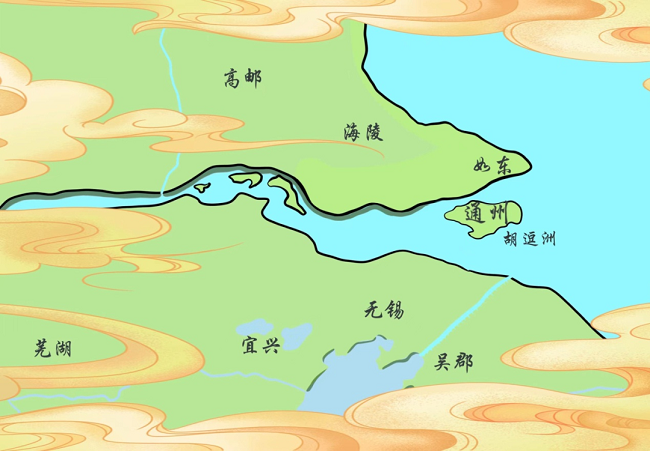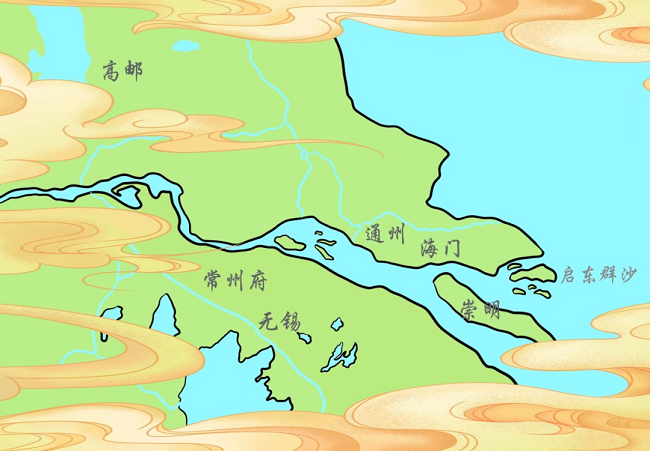
Nantong sits at the confluence of the Yangtze River and the Yellow Sea.
It is both ancient and young in the sense that its northwestern area was the first to take shape and then gradually extended southward and eastward.
The city's history comprises five stages:
Stage I The prehistoric period

At this time, Nantong was within a trumpet-shaped estuary of the Yangtze River.
Most of the mud and sand that reached the river mouth were deposited, forming an underwater delta.
As the main stream of the river gradually moved southward, sand banks at the river mouth gradually extended northward.
On the north bank of the Yangtze River, the ancient Yangzhou-Taizhou Barrier Spit, which ran from Yangzhou through Taizhou to Libao, was formed and soon after populated with fauna.
Chinese people then settled there.
The Hai'an and Rugao areas were within the ancient Yangzhou-Taizhou Barrier Spit and both took shape around 5,000 to 6,500 years ago.
Palaeoclimatological studies show that around 4,000 to 3,000 years ago, high sea levels emerged, marine transgressions occurred in the Yangtze River Delta and other low-altitude areas, and ancient prehistoric civilization was interrupted.
Stage II From the Qin Dynasty (221-206 BC) to the Tang Dynasty (618-907)

During the Qin Dynasty, current southern Nantong was all underwater except for Lang Mountain.
During the Han Dynasty (206 BC-220), the river shoreline extended from present-day Rugao to Libao, and the ancient Rudong sandbar group appeared.
From the Southern and Northern Dynasties (420-581) to the early Tang Dynasty, the ancient Rudong sandbar group gradually grew to form the Fuhai Sandbar, which constantly expanded toward the Yangtai Mound that was expanding eastward.
In the seventh year of the rule of Emperor Xiaowu of Jin (382), the Fuhai Sandbar joined the ancient Yangzhou-Taizhou Barrier Spit and became integral to the ancient Bei'an Barrier Spit.
During the early Southern Liang Dynasty (502-530), sandbars such as Hudou and Nanbu appeared next to the mouth of the Yangtze River.
By the Tang Dynasty, the Hudou Sandbar became a river island stretching 40 kilometers horizontally and 15 km vertically, covering present-day Chongchuan District, Pingchao, Liuqiao, and Xiting.
Present-day Jinsha was then a part of the Nanbu Sandbar.
At the end of the Tang Dynasty, two large sandbars, known as Dong and Bu, appeared next to the mouth of the Yangtze River.
They were jointly referred to as the Dongbu Sandbar.
Stage III From the Five Dynasties and Ten Kingdoms (907-960) to the Early Northern Song Dynasty (960-1297)

At the end of the Five Dynasties and Ten Kingdoms, the Hudou Sandbar joined the ancient Bei'an Barrier Spit along with the Nanbu Sandbar.
The Dong and Bu sandbars, located in the sea outside the mouth of the Yangtze River, were jointly referred to as the Dongbu Sandbar after they connected and were collectively called Haimen Island together with surrounding sandbars.
Stage IV From the mid-late Northern Song Dynasty to the early Yuan Dynasty (1271-1368)
During the Qingli and Huangyou periods of the Northern Song Dynasty, Haimen Island and the eastward-expanding Hudou Sandbar connected and jointly formed the Tonglu Shuiji plain.
This marked the third extension of the Bei'an Barrier Spit.
Stage V From the late Yuan Dynasty to the Qing Dynasty (1644-1911)

The global average temperature increased between the 14th and 15th centuries, leading to rising sea levels.
As a result, the main stream of the Yangtze River moved northward, which caused the collapse of its north bank.
It was not until around the 40th year of the rule of Emperor Kangxi of Qing (1701) that the river flowed back southward and sand began to accumulate along the river.
Some sandbars emerged first and then gradually connected and formed the present-day Qihai area in the modern Yangtze River Delta plain.





